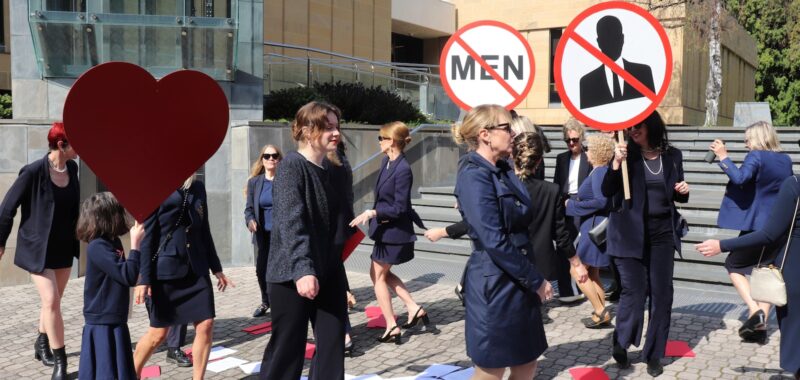WELLINGTON, New Zealand — A museum in Australia was within its rights to bar men from a controversial art exhibit for women meant to underscore their exclusion from segments of the male-dominated society, a top regional court said on Friday.
The development is the latest in the long-running saga of the “Ladies Lounge” exhibition that has provoked an uproar in the art world. Its curator, Kirsha Kaechele, admitted in June she had created all the art, including the paintings she had billed for years as works by Spanish master Pablo Picasso without anyone noticing they were fake.
On Friday, Tasmania’s Supreme Court threw out on appeal an order for Tasmania’s Museum of Old and New Art, where the exhibit opened in 2020, to stop refusing male patrons entry to the show. It said the lower tribunal should have found that the “Ladies Lounge” was exempt from Australia’s gender discrimination law.
The appeals court asked Tasmania’s Civil and Administrative Tribunal to reconsider its ruling from April in the case brought by a disgruntled male visitor. It wasn’t immediately clear when the case would be revisited.
Associate Justice Shane Marshall wrote in his ruling Friday that the lower body was wrong when it decided the exhibition did not qualify for an exemption to gender discrimination laws. The exhibition was intended to promote equal opportunity for women — who suffer ongoing gender disadvantage — by excluding men, he said.
When the museum first lost the suit, Kaechele relocated the paintings to a women’s restroom at the gallery — rather than allow male visitors to see the art.
The fracas, however, continued, with the Guardian newspaper eventually questioning the authenticity of the art work after the museum published a picture of a supposed Picasso hanging above a toilet.
Friday’s ruling was a victory for Kaechele, who said in July that the purpose of the “Ladies Lounge” — open to all who identified as women — was to make men “feel as excluded as possible.”
Catherine Scott, a lawyer representing the museum, said the ruling Friday recognized that the “Ladies Lounge” challenged inequality by “providing a flipped universe where women experience advantage.”
During the hearings, Scott had presented a 2024 report card by the Australian government on gender equality, which shows that women working full-time earn 12% less than men.
Kaechele claimed the court’s decision reflected what she holds as “a simple truth: women are better than men.”
Jason Lau, the New South Wales resident who brought the case against the museum, did not appear in court — neither during the initial lawsuit nor during the appeal — and has never spoken publicly about it.
Lau’s lawyer, Greg Barns, said he was unable to comment on the case and did not respond to a request to speak to his client.
When the appeal hearing opened last week, Kaechele repeated her performance from earlier, showing up at the Supreme Court in Tasmania’s city of Hobart surrounded by dozens of women supporters in navy-colored suits and wearing bright red lipstick. The women danced out of the court in single file, some holding placards denouncing men.
“Yes, the men, understandably, are a little grumpy about this,” Kaechele wrote on Instagram after Friday’s ruling. “They may even appeal. (They do not appeal to me.)”
When Kaechele announced in July that she had created the artwork at the exhibit, including the supposed Picasso paintings, she provoked a debate among art critics.
Detractors said that to knowingly display forgeries undermined a gallery’s credibility and that Kaechele was making a joke at her women patrons’ expense by passing off worthless trinkets as art.
But many gallery visitors appeared to be in on the act.
In March, a panelist on the Australian current events show “The Project” on Network 10 described being forced to wait outside while his female companions visited the exhibition.
“I begged to find out what happened, but no one said anything,” Sam Taunton told the program. “My girlfriend said it was the greatest experience of her life.”

